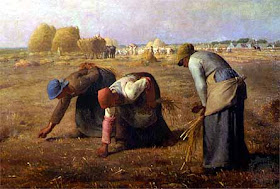
http://calamandayledesesperedegustavecourbet.blogspot.com.es/2009/02/las-espigadoras-el-angelus-jean.html
The painting I have chosen is The Gleaners (Des Glaneuses in French) by Jean-François Millet. The painting was painted in 1857 and it’s a real representation of gleaner women. This painting was painted on oil on canvas and its dimensions are 83.5cmx110cm. This painting was presented at the Salon of Paris but when the critiques started, Millet sold his work for 3,000 francs to an Englishman called Binder. After Millet’s death his work started being appreciated and the banker Ferdinand Bischoffsheim purchased the painting at an auction for 300,000 francs. Then the painting was donated to the Louvre, but this painting is exhibited in the Orsay Museum in Paris now. The Gleaners was considered to be one of the most important paintings of Realism. Millet wanted to represent the realism of the 19th century, but his painting had a bad reception among the French upper class.
The gleaners in the Orsay Museum

Jean-François Millet had to move to Normandy, because he wanted to reflect the rural life of this place. The Gleaners represents the rural life, a field where three women are collecting corn grains. They are exactly collecting the fallen grains that men left on the ground after the harvest. This activity was commanded only to determinate women in the town. The central figures of the painting are three women dressed with the typical peasants’ clothes, but also with the coloured and typical clothes of Normandy. These clothes have colours such us pink and green to make the painting more colourful and less self-sacrificing.
On this painting the gleaners represent the hard work of the women in this period of history and also some samples of pain, such the hand over the back of one woman and the representation of fatigue at the end of a labour day. A gleaner was normally a woman who had to collect the grains of corn that men didn’t collect before. This work was very hard because they had to work from sunrise to sunset, bending over, picking up the grains and straightening many times. We can’t see the face of the three women. Behind the central figures, in the background there are the hayricks, sheaves of wheat and some carts. Also behind the carts there are some peasants (men) in a laborious work.
Millet represented the daily peasant life with a colourful point of view. This painting is a critical topic, because it reports the bad working conditions of women and also their poverty. Millet gave the three women a heroic role for their hard work and also, because their work wasn’t grateful. Millet used oil painting technique, because he wanted to represent the movement of the three women collecting the wheat harvest. He also used geometrical forms, such as the circle. On this painting the predominant colours are the warm colours to stand out the gleaners. The light of this painting is very natural and it gives the painting a good and clear point of view, because it represents a sunny day. Millet painted the gleaners with very slow brush-strokes because he wanted to reflect the three women as heroines. Millet painted a previous version of this theme. He painted the gleaners in some drawings, but this is considered the first one on oil painting.
This drawing may have immediately preceded the painting, but it was more likely drawn from it, as Millet frequently repeated and recorded his favourite motifs.
Jean-François Millet is considered to be one the most important realist painters because he represents the more bucolic aspect of peasants’ life. Millet represented the real theme of the lower class and the bad working conditions of these people. This caused a lot of criticism. Millet could make a real social report with this piece.
Millet not only represented the lower class on this painting, but also in The nap
Millet also represented the lower class in The Angelus.

Millet influenced Van Gogh, who admired him. There is another Millet’s painting Van Gogh used as model for several paintings: The Sower.
Millet’s painting The Sower
Millet’s The Sower
Van Gogh’s painting The Sower
One interesting thing about The Gleaners is that I have found a film. The film is called Les glaneurs et la glaneuse (The gleaners and I) and it was directed by Agnès Varda. The film is about how the food some people throw one day to the rubbish can feed other people for a whole week. This film shows the bad working and living conditions of people at a specific place and time.
I like this painting because it’s very colourful and transmits a sensation of calm and quietness. I also like the painting because it shows the real lower class and this serves to make the people aware of a situation. It’s also a sensitive painting because you can see the pain and fatigue of the three women. The Gleaners is a very interesting painting. I have learned a lot with this work.
http://es.wikipedia.org/wiki/Las_espigadoras
http://elblogdegeografia.blogspot.com.es/2010/02/las-espigadoras-millet.html
http://calamandayledesesperedegustavecourbet.blogspot.com.es/2009/02/las-espigadoras-el-angelus-jean.html
http://festivalcinesevilla.eu/es/secciones/agnes-varda/los-espigadores-y-la-espigadora
http://www.reproarte.com/picture/Jean-Fran%C3%A7ois_Millet/Summer+-+The+gleaner+women/7513.html
http://www.britishmuseum.org/explore/highlights/highlight_image.aspx?image=ps339332.jpg&retpage=21566
http://www.musee-orsay.fr/en/collections/works-in-focus/search/commentaire/commentaire_id/des-glaneuses-341.html?no_cache=1
http://www.vangoghmuseum.nl/vgm/index.jsp?page=178899&lang=en
http://1001movieman.blogspot.com.es/2011/07/946-les-glaneurs-et-la-glaneusethe.html
I hope you like it :)





Hello Elena,
ReplyDeleteI've corrected some small mistakes directly. Your mark is 9. See you!